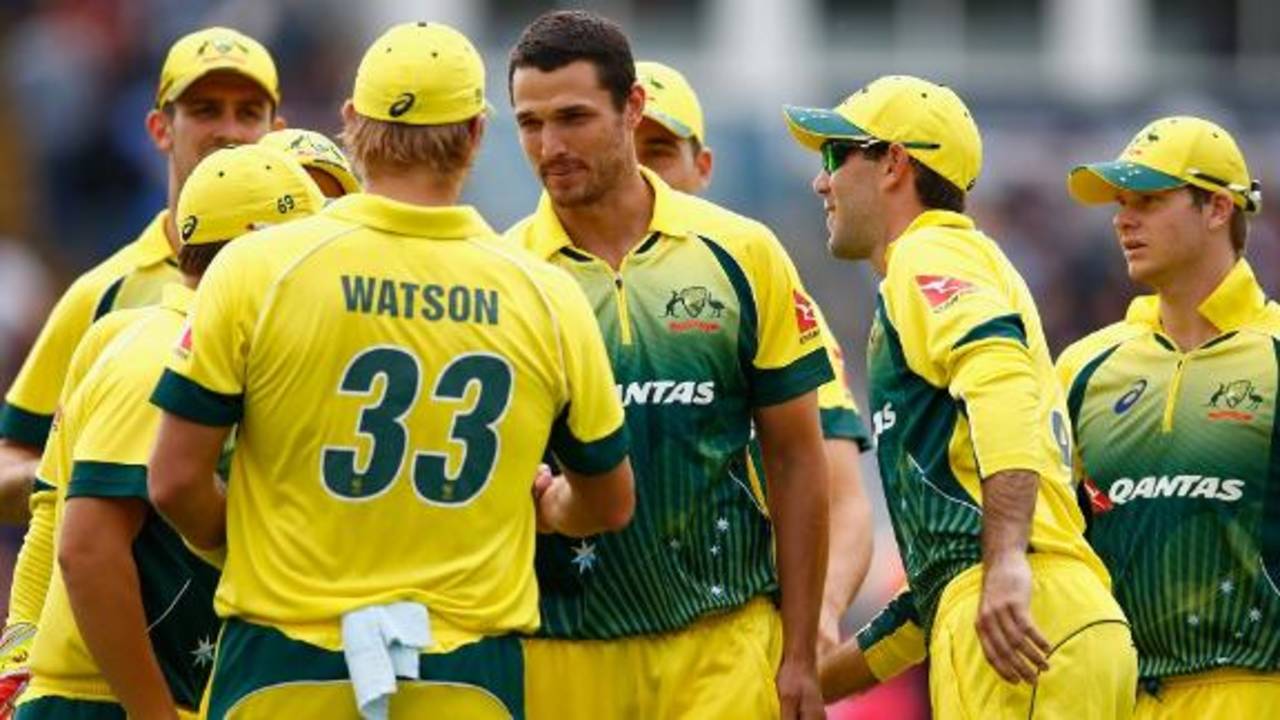How deep are Australia's pace reserves?
With Ryan Harris and Mitchell Johnson retired and Mitchell Starc out injured, Australia's fast-bowling depth is set to be seriously tested over the next few months
Brydon Coverdale
01-Dec-2015
A year ago, you might have worried about the depth of Australia's batting talent. Or of their spin-bowling options. But pace? That has been the least of their concerns. Still is, according to the national selector Rod Marsh, who announced Australia's latest Test squad on Tuesday. Marsh said that Australia's "depth chart" - those were his words - showed "20 fast bowlers that we rate a chance of playing" internationals in one of the three formats.
We might soon find out whether Australia's pace-bowling depth is really as impressive as those numbers suggest, or whether it more resembles Paul Keating's withering description of Peter Costello: all tip and no iceberg. Mitchell Johnson and Ryan Harris have retired. Mitchell Starc is injured, as are a number of replacement candidates. Josh Hazlewood's workload worries the team management, and Peter Siddle's back is troubling him.
So, how far down into Australia's domestic scene does the quality of fast bowling really penetrate? It is a question worth considering, given that the selectors have chosen in the squad for the first Test against West Indies a man who has not played a single Sheffield Shield game this summer due to injury and suspension. Nathan Coulter-Nile has no recent red-ball form, yet he was the man all the selectors thought of when Starc was ruled out.
As well as James Pattinson retaining his place in the squad, the other man to receive a call was Victoria fast bowler Scott Boland, who has been placed on standby in case either Siddle or Hazlewood struggles to recover after Adelaide. Marsh noted that it was unlikely Hazlewood would be able to sustain himself through six Tests this summer, with a New Zealand tour to follow, so Coulter-Nile and Boland both have realistic chances of playing Test cricket soon.
"We don't think anyone is unlucky with this selection," Marsh said. Translation: despite the "depth chart", no other fast bowlers were close. These selectors want speed; Marsh said that a properly quick bowler was needed in the absence of Johnson and Starc. Jackson Bird and Chadd Sayers suffer from the perception that they are not quick enough, even though Bird was Man of the Match in his second Test, three years ago.

Jackson Bird is the highest wicket-taker in the Sheffield Shield this season and has an enviable first-class record in Hobart, but his lack of pace has counted against him under the current selection regime•Getty Images
Bird is also the leading wicket taker this Shield season with 18 at 24.77, and he knows the Bellerive Oval surface intimately: he has taken 71 first-class wickets there at 19.81. That he was not picked for Hobart against West Indies suggests he is unlikely to add to his three Test caps, at least in the near future. Then again, Bird hasn't bashed the door down; his five-wicket haul in the most recent Shield round was his first in 18 months.
So, who else is there? The Western Australia left-armer Jason Behrendorff would have come under serious consideration had he been fit, but he is struggling with a back injury. Pat Cummins also faces a long lay-off due to stress fractures of the back. James Faulkner has a toe injury that is also causing him knee problems.
Andrew Fekete was part of Australia's squad for the cancelled Test tour of Bangladesh, but has since been dropped by Tasmania and has 12 wickets at 40.83 this Shield season. Ben Hilfenhaus' pace is down and Tasmania have sent him back to Futures League and grade cricket. Gurinder Sandhu, who made his ODI debut earlier this year, has little recent red-ball form to recommend him.
In fact, let's run through the list of highest Sheffield Shield wicket takers over the past two years, excluding spinners. Top of the heap is James Hopes, the 37-year-old Queensland medium-pacer whose canniness has earned him 72 wickets at 19.51 in that time. Next is Fekete. Then Michael Hogan, who plays for Western Australia as an overseas player because he has used his British passport to play county cricket as a local.
Next is Doug Bollinger, with 50 wickets at 22.52. He is 34 and his last Test was five years ago. Would he be up to a recall? Then comes Behrendorff and the South Australian Joe Mennie, who has 47 wickets at 34.17, and is second to Bird this season. Then it's Boland, Sean Abbott, Bird, Sayers and Tasmania's Sam Rainbird, who has 40 wickets at 29.15. Two other names of note are Joel Paris, another WA left-armer who swings the ball, and Billy Stanlake, the tall Queenslander. Marsh made mention of both as men for the future, if not the present.
"Joel Paris is an interesting one, he's played his first ever four-day game against Victoria this week and from all reports bowled quite nicely," he said. "He's one that we'll be keeping our eye on for sure, because he's very tall and he swings the ball and he had a brilliant junior career. Billy Stanlake is another one, from Brisbane. We've got two youngsters who I think, going forward, will be very good fast bowlers for Australia."
In the end, the selectors went for Coulter-Nile due to a "gut feeling" among the panel. "We like him as a bowler," Marsh said. Some fans have had a gutful of such selection hunches, but do any of those other names jump out as demanding selection? In whatever direction the selectors went, a leap of faith was required. What is certain is that Australia's fast-bowling depth is about to be seriously tested.
Brydon Coverdale is an assistant editor at ESPNcricinfo. @brydoncoverdale
